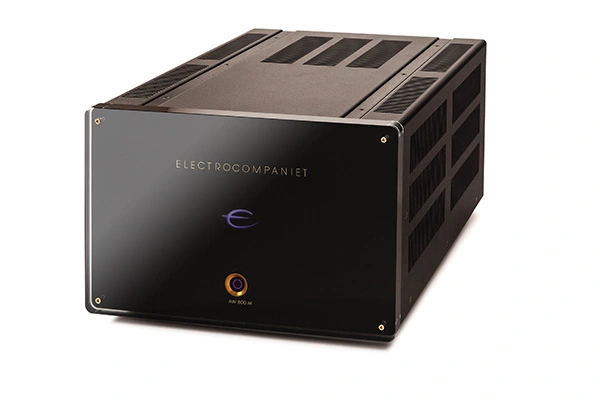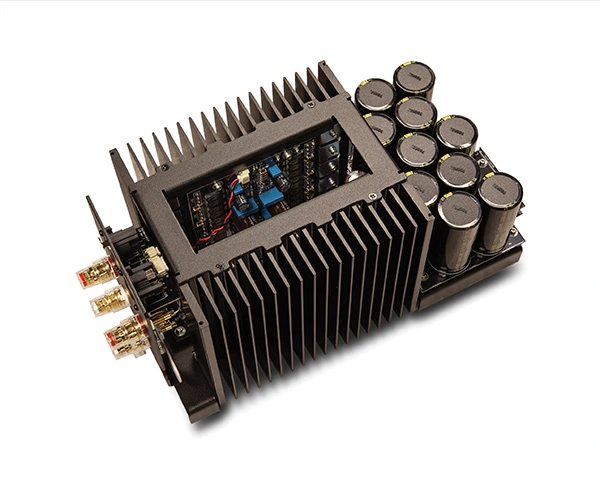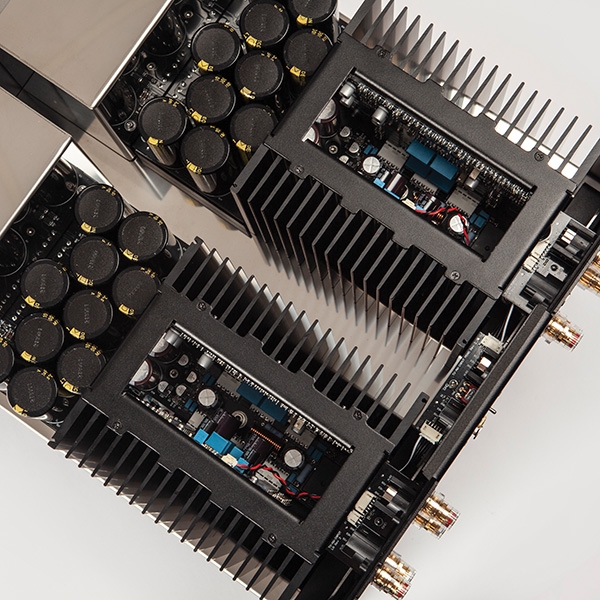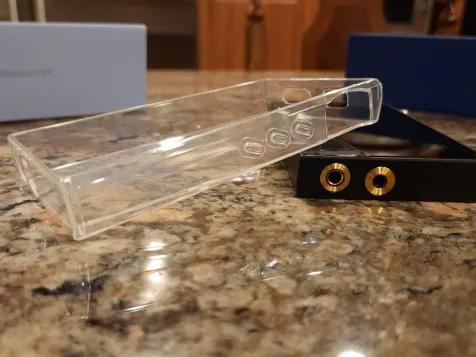Electrocompaniet AW 800 M stereo/monoblock power amplifier

In 1992, I had the best soup I had ever had in Kamakura City, Japan. I ascended a mountain to a shrine containing a lock of Buddha’s hair, then I walked to the Great Bronze Buddha of Kamakura.
My stomach was growling by the time I’d had enough of the 730-year-old glories of the image and the many visitors posing for pictures at its foot, a minor preface to “the world is a backdrop for my ego” snappers of the smartphone age.
Tired, I made my way back into the town and strolled down stairs into a handy corner eatery. With my train return coming shortly, I had to eat quickly. I ordered eel over rice and miso soup because I was in a hurry. You can only imagine how shocked I was to look into the most amazing bowl of soup I had ever seen.
Its soup was clear and brown, with a variety of vegetables and herbs floating on top that were all precisely arranged in relation to one another, like pieces of handwoven fabric. It was as if I had been given exclusive access to a magnificent piece of art.
Moreover, the flavor. Oh, the flavor. It was as intricate, multi-layered, and precisely proportioned as the surface of the soup. Had I not had to eat quickly to catch the train (Japanese trains are never late), I would have taken my time, taking in every bite and reflecting on the variety of flavors and experiences, for fifteen or twenty minutes.
What connection does all of this have to the power amplifier under study, the Electrocompaniet AW 800 M Reference ($22,500/each)? To find out, you’ll have to keep reading.

Before the soup, there was Electrocompaniet
Fifty years ago, in Norway, Nils Bjarne Kvam founded Electrocompaniet, eight years before Krell released its first solid-state amplifier. Following his attendance at a symposium where renowned professor Dr. Matti Otala gave a paper on how to prevent the transient intermodulation distortion that kept transistor-based amplifiers from producing sound that was credible and high-fidelity, Kvam returned to Norway, teamed up with Per Abrahamsen, a manufacturer of PA systems, and started building some prototype amplifiers.
Electrocompaniet introduced its first power amplifier, a two-channel, 25Wpc unit, three years later, in 1976. It was instantly praised as the world’s best-sounding transistor amplifier by The Audio Critic.
Now celebrating its 50th year, Electrocompaniet employs six people, most of whom work in sales and development. Westcontrol, a sister company of Electrocompaniet, is in charge of manufacturing the audio products for Electrocompaniet at a sizable electronics production plant next door.
Near the beginning of our conversation at AXPONA 2024 Lasse Danielsen, the director of sales and marketing at Electrocompaniet, remarked, “We had good distribution in the US back in the day.” I had not yet heard the Electrocompaniet AW 800 M Reference monoblocks when I got down with Danielsen, Björn Kindingstad, CEO of Electrocompaniet, and Frank Gazzo, national sales manager of Antal Distribution.
“Then, when things weren’t going well, we took over the distribution management for a while. We collaborated with Antal to revitalize distribution in the US because it didn’t work out either.” There were twelve US dealers for Electrocompaniet at the time of our conversation. After two months, the total had increased to fifteen. For 15 Electrocompaniet models, there are fifteen dealers.

From what I was able to gather at the time and from several e-mails that followed, the Electrocompaniet AW 800 M Reference’s design is brand new, “from the ground up.” Three years after its creation, the amplifier made its debut on the market in January 2023. It is a fully discrete, true-balanced class-AB design with roughly 10W in pure class-A, according to Danielsen.
Everything that comes before the output stage of the amplifier operates in pure class A. Large 800W into 8 ohms, 1500W into 4 ohms, and a powerful 2200W into 2 ohms are the output levels.
“Every parameter inside the amp is way ahead of anything we’ve ever produced before,” Danielsen stated. “It has two bridged amplifiers inside a dual-monoblock arrangement. On the back is a switch that allows you to use it as two separate amplifiers in stereo mode or as a biamping amplifier with another amplifier.
It has been completely revamped with improved components, a better transformer, and improved mechanical and electrical isolation—all based on the same topology that we have previously employed. This is the blackest-sounding amplifier we have ever created, with an incredibly low noise floor. When you hear the calm passages in the song, it’s completely dark.
“The amplifier incorporates an RF filter designed to remove common mode and differential high-frequency noise from the line. The transformers have an electrostatic barrier that prevents noise from coupling as it travels between the primary and secondary wiring.
An integrated DC filter minimizes asymmetric main AC voltage and keeps DC voltage from overloading transformers and creating mechanical noise.
For these reasons, Danielsen stated that Electrocompaniet has achieved the best results by plugging the amplifier directly into the wall rather than a power conditioner. I chose to follow their lead.

“The amplifier incorporates an RF filter designed to remove common mode and differential high-frequency noise from the line. The transformers have an electrostatic barrier that prevents noise from coupling as it travels between the primary and secondary wiring.
An integrated DC filter minimizes asymmetric main AC voltage and keeps DC voltage from overloading transformers and creating mechanical noise.
For these reasons, Danielsen stated that Electrocompaniet has achieved the best results by plugging the amplifier directly into the wall rather than a power conditioner. I chose to follow their lead.
“The amplifier incorporates an RF filter designed to remove common mode and differential high-frequency noise from the line. The transformers have an electrostatic barrier that prevents noise from coupling as it travels between the primary and secondary wiring.
An integrated DC filter minimizes asymmetric main AC voltage and keeps DC voltage from overloading transformers and creating mechanical noise.
For these reasons, Danielsen stated that Electrocompaniet has achieved the best results by plugging the amplifier directly into the wall rather than a power conditioner. I chose to follow their lead.
Danielsen obtained information from the engineer at Electrocompaniet and added to it via email over time. The text has been updated to read as follows: “The AW 800 M makes use of the direct-coupled high open-loop bandwidth architecture from Electrocompaniet, which is further improved with very high bandwidth and high slew rate amplifier stages. We have always referred to our architecture as “Ampliwire,” or “AW.” We refer to the improved AW technology in this new amplifier as “Ampliwire 2.”
The phrase refers to the fact that the amplifier ‘amplifies the wire’ coming from the source without modifying or enhancing the sound in any manner. As a result, the sound is kept as authentic as possible.
“The amplifier incorporates an RF filter designed to remove common mode and differential high-frequency noise from the line. The transformers have an electrostatic barrier that prevents noise from coupling as it travels between the primary and secondary wiring.
An integrated DC filter minimizes asymmetric main AC voltage and keeps DC voltage from overloading transformers and creating mechanical noise.
Electrocompaniet
For these reasons, Danielsen stated that Electrocompaniet has achieved the best results by plugging the amplifier directly into the wall rather than a power conditioner. I chose to follow their lead.
Furthermore, a newly designed output stage of 32 high-bandwidth, high-current bipolar output transistors provides robust shielding between the driver and input stages and the load, resulting in an exceptionally stiff output that remains unaffected by the attached load. Additionally, this greatly reduces the effort of the feedback system, which is already operating gently and produces vanishingly low distortion values.

“The amplifier incorporates an RF filter designed to remove common mode and differential high-frequency noise from the line. The transformers have an electrostatic barrier that prevents noise from coupling as it travels between the primary and secondary wiring.
For these reasons, Danielsen stated that Electrocompaniet has achieved the best results by plugging the amplifier directly into the wall rather than a power conditioner. I chose to follow their lead.
“The amplifier incorporates an RF filter designed to remove common mode and differential high-frequency noise from the line. The transformers have an electrostatic barrier that prevents noise from coupling as it travels between the primary and secondary wiring.
For these reasons, Danielsen stated that Electrocompaniet has achieved the best results by plugging the amplifier directly into the wall rather than a power conditioner. I chose to follow their lead.
The revised power supply has 210,000µF of supply filtering to feed the output stage. The main power input is DC and RF-filtered. The updated twin-toroidal, wire-gauge transformers are magnetic and electrostatically protected to reduce noise interference. The internal ground reference has been greatly increased and kept completely free of rectification and output currents. The end result is a highly clean, noise-free output signal independent of output power, resulting in a very consistent soundstage with the blackest background conceivable at any volume level.
“The amplifier incorporates an RF filter designed to remove common mode and differential high-frequency noise from the line. The transformers have an electrostatic barrier that prevents noise from coupling as it travels between the primary and secondary wiring.
An integrated DC filter minimizes asymmetric main AC voltage and keeps DC voltage from overloading transformers and creating mechanical noise.
“The AW 800 M has also received design updates, including a new front plate with a 3D logo and a new power button design. The chassis was redesigned from the ground up. Its innovative modular design architecture has been improved by two black, brushed-aluminum rods on top, which make the chassis much more sturdy and add to its visual appeal.”
The Electrocompaniet signature sound
“The amplifier incorporates an RF filter designed to remove common mode and differential high-frequency noise from the line. The transformers have an electrostatic barrier that prevents noise from coupling as it travels between the primary and secondary wiring.
An integrated DC filter minimizes asymmetric main AC voltage and keeps DC voltage from overloading transformers and creating mechanical noise.
For these reasons, Danielsen stated that Electrocompaniet has achieved the best results by plugging the amplifier directly into the wall rather than a power conditioner. I chose to follow their lead.
Kindingstad stated that the new design was not prompted by dissatisfaction with the performance of earlier amplifiers; “We just knew we could do better.” The entrance of a new engineer, who had fallen in love with Electrocompaniet’s sound and studied its engineering since he was a child, opened the door to “better.”.
“Soundwise, we believe there is warmth to our sound,” Kindingstad remarked. “That does not imply that it is erroneous or biased in any manner. Distinct amplifiers have distinct voices, just as one vocalist has one and the other has another. That does not imply that one is out of tune; they simply sound different.
amplifier
“The amplifier incorporates an RF filter designed to remove common mode and differential high-frequency noise from the line. The transformers have an electrostatic barrier that prevents noise from coupling as it travels between the primary and secondary wiring.
For these reasons, Danielsen stated that Electrocompaniet has achieved the best results by plugging the amplifier directly into the wall rather than a power conditioner. I chose to follow their lead.
“We want people to appreciate and concentrate on music. We believe you will never become weary of our amplifiers’ organic, warm, and genuine sound after listening to them for a considerable amount of time.”
Kindingstad described the acoustic signature of Electrocompaniet components as “the Nordic Tone” or “Nordic Sound,” which left me wondering what terms I may someday use to describe the sound of an amplifier I would experience for the first time later that day at AXPONA.
“The amplifier incorporates an RF filter designed to remove common mode and differential high-frequency noise from the line.
An integrated DC filter minimizes asymmetric main AC voltage and keeps DC voltage from overloading transformers and creating mechanical noise.
For these reasons, Danielsen stated that Electrocompaniet has achieved the best results by plugging the amplifier directly into the wall rather than a power conditioner. I chose to follow their lead.
“Our sound is crisp, lovely, and incredibly detailed, but it is also a little bit soft. It reminds me of something natural and airy, like strolling in the woods and listening to the sound of a brook.” I’ve spent time with a dB meter in my hand, paying close attention to the sound of the water along the Olympic Peninsula’s Quilcene River. I was curious.
“The amplifier incorporates an RF filter designed to remove common mode and differential high-frequency noise from the line. The transformers have an electrostatic barrier that prevents noise from coupling as it travels between the primary and secondary wiring.
An integrated DC filter minimizes asymmetric main AC voltage and keeps DC voltage from overloading transformers and creating mechanical noise.
For these reasons, Danielsen stated that Electrocompaniet has achieved the best results by plugging the amplifier directly into the wall rather than a power conditioner. I chose to follow their lead.
Danielsen said, “It sounds like nature.” A few miles from our workplace lies one of the most well-known sights in Norway. You can see the large mountains and the setting light over the fjord, which is surrounded by an incredibly untamed landscape.
As you experience the height of the mountains and the depth of the fjords, it’s quite soft, but it’s also a little deep. And, as much as we appreciate the lovely, smooth features of nature, we also welcome the harshness of the hard mountain landscape and the dramatic nature of our area of the planet. We attempt to recreate the complete ambiance.”
“The amplifier incorporates an RF filter designed to remove common mode and differential high-frequency noise from the line. The transformers have an electrostatic barrier that prevents noise from coupling as it travels between the primary and secondary wiring.
An integrated DC filter minimizes asymmetric main AC voltage and keeps DC voltage from overloading transformers and creating mechanical noise.
For these reasons, Danielsen stated that Electrocompaniet has achieved the best results by plugging the amplifier directly into the wall rather than a power conditioner. I chose to follow their lead.
Classical music fans won’t be shocked to hear that Danielsen mentioned Edvard Grieg’s “Morning Mood” from Peer Gynt when asked what song best represents the Nordic tone. He stated, “It begins with the sun rising.” A small amount of dew has formed on the grass, and you can hear the insects and tiny birds awakening.
Then, as the sun fully emerges, you have this beautiful melody. It’s a very wonderful, smooth Norwegian mood with the darkness of the trolls in the ground and the glory of the rising sun, so you should listen to it.”
“The amplifier incorporates an RF filter designed to remove common mode and differential high-frequency noise from the line. The transformers have an electrostatic barrier that prevents noise from coupling as it travels between the primary and secondary wiring.
For these reasons, Danielsen stated that Electrocompaniet has achieved the best results by plugging the amplifier directly into the wall rather than a power conditioner. I chose to follow their lead.
As I pondered over the distinction between Grieg’s portrayal of the morning and Richard Strauss’s Alpine Symphony, I inquired about Danielsen’s preferred versions of Peer Gynt. I decided to give at least one of the recommendations that I received via email some attention.







